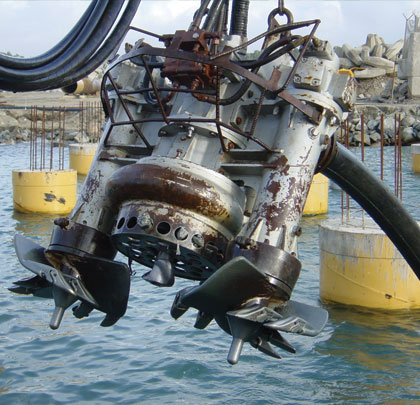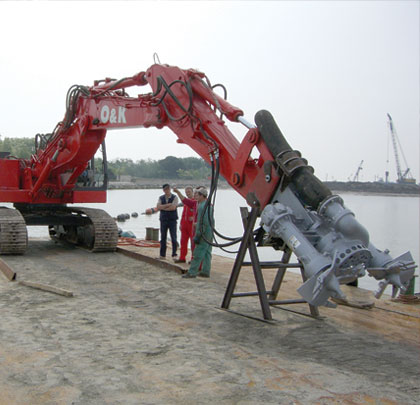Tunnelling contractor Gallagher’s contacted Euroflo to supply a dredging pump system for a major rail-tunnelling project in east London, the Connaught Crossing, which dates back to the latter half of the nineteenth century. A project of this scope required extensive planning and careful attention to detail. One of the challenges that Euroflo addressed successfully required the combination of different pumps along the system to account for differing needs in the complex dredging.
PREPARED FOR PUMPING
Cofferdams were positioned at the Royal Albert and Royal Victoria docks, some 164.04 feet (50 meters) apart. This left water between the two Cofferdams, which was then pumped out to leave a residue of heavy silt and slurry, situated 49.21 feet (15 meters) below.
The civil engineering works involved the accessing of tunnels through the base of the excavation in order to enlarge the existing tunnels. Initially they used standard diesel driven hydraulic drainer pumps in an attempt to pump heavy silt and slurry from the bottom of the excavation; however these pumps were completely unsuitable for a dredging pump application and continuously blocked causing lengthy delays.
HEAVY LIFTING FIRST
Euroflo proposed a temporary dredging pump system that would cope with the heavy slurry and supplied the entire packaged solution; including generators, control equipment, cabling, pumps, and pipework. This was to move the heavy slurry with a specific gravity of around 1.3, so Jetting rings were required to create the conditions of a 70 to 30 percent ratio of water and soil mix for pumping.
As part of the package Euroflo installed a Dragflow dredging pump, along with a jetting ring attachment. Water was high pressure jetted by a Grindex drainage pump to help break up the heavy material. This was accompanied by a smaller Toyo dredging pump that could be more easily moved around for slurry Pump transfer to the main Dragflow dredging pump from around the dock floor.
The Dragflow dredging pump was positioned at the deepest part of the excavation so that the material would gravitate towards the dredging pump with the use of excavators and Euroflo’s other smaller more mobile dredging pumps. The larger Dragflow dredging pump then discharged the material over the cofferdam 328.08 feet (100 meters) away.

One of the Dragflow dredging pumps used in this project.
THE TECHNICAL CHALLENGE
Euroflo were then commissioned to automate the operation of the Dragflow heavy-duty slurry pump system to run as required unmanned. Once the slurry removal process was complete an 8 inch (203 millimeter) Grindex Maxi drainage pump was installed to manage the water levels for the remainder of the project.
The technical challenge was fairly straightforward. The key to success in managing high specific gravity applications is to keep the material moving and critical to that is the right pump selection with slow revolution motors. Euroflo recommend heavy-duty hard iron pumps for dredging pump applications, which will withstand the often abrasive and sometimes corrosive environments.
Because of variable densities of slurries and compacted material we recommended jetting the material at high pressure. A Grindex master pump was suspended in the main dock and delivered water at 43.51 psi (3 bar) pressure over the 49.21 foot (15 meter) Cofferdam delivered to a tee piece with one spur used for the jetting ring to create agitation and the other spur used to provide cooling water to the Dredging pump. A submersible pump is normally cooled by the media its submerged in, but in this case it was only possible to semi-submerge the Dredging pump which meant it needed to be kept cool by water spray from the Grindex Master, thus avoiding overheated motors and breakdown.
A Dragflow hard iron dredging pump with a 44 kilowatt motor was installed with an 8-inch (203-millimeter) discharge and pumped 328.08 feet (100 meters) through a wire armoured hose. The six pole, three phase 50 Hertz, 60 horsepower, runs at 980 revolutions per minute. This slow running motor spins the impeller slowly to move the heavy material. A fast motor (2800 revolutions per minute) would either spin the impeller too fast cutting through the material which is unproductive or it would block quickly against the resistance of the heavy material, thus overloading and burning the motor.
SOLVING SHORT STARTING
When a pump starts up it can use up to 6 to 7 times its running amps if a direct-on-line (DOL) electrical starter is used. This can mean using a disproportionately large generator to cope with a short starting phase. To solve this problem, Euroflo used soft-start 18 to 55 kilowatt electrical panels which peak at 2.5 time running amps and consequently require a much smaller generator, which reduces costs. Euroflo used pre-programmable soft starts set above the working parameters of the pumps at 95 amps, slightly higher than its 89 running amps to protect from pump overload.
The cable supplied on all Euroflo pumps is individually screened and designed to go to earth immediately the cable is cut rendering the cable literally powerless and completely safe, in the event of an accident. The generator sized at 150kva was supplied with a fully bunded 528.34-gallon (2000-liter) diesel tank. A total of 6000 Qm3 approximately of slurry was moved over ten weeks with intermittent breaks and used 12000 to 18000 Qm3 of water to mix with slurry. Toward the end of the project, a 37 kilowatt Grindex maxi pump was installed and level controls were introduced to manage intermittent residual slurries and Cofferdam leakage. ■
_________________________________________________________________________
ABOUT THE AUTHOR
Dan Langrish is the digital marketing executive for Euroflo Fluid Handling Ltd., who has been providing expert industrial and submersible pump services for more than fifteen years, and specializes in the electrical submersible pump industry. Euroflo exclusively represents Grindex submersible drainage pumps and Dragflow submersible slurry pumps. For more information, visit www.euoflo.com.
_________________________________________________________________________
MODERN PUMPING TODAY, October 2013
Did you enjoy this article?
Subscribe to the FREE Digital Edition of Modern Pumping Today Magazine!
![]()


